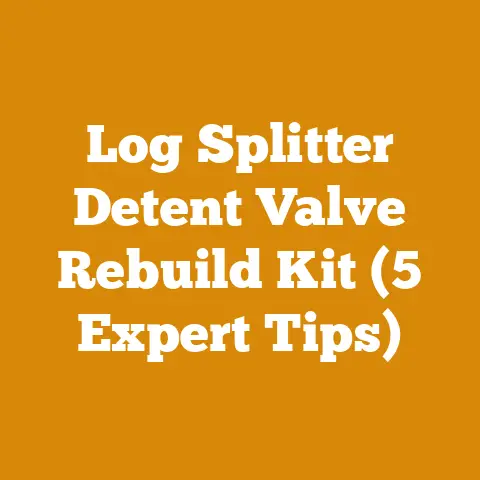MS391 Muffler Mod (5 Pro Tips for Power Boost)
Okay, let’s dive into unlocking more power from your Stihl MS391 chainsaw with a muffler modification. I’ve spent years in the woods, felling trees, processing timber, and prepping firewood. I’ve seen firsthand how a well-tuned saw can dramatically improve efficiency and reduce fatigue. While a muffler mod isn’t a magic bullet, it can be a worthwhile upgrade when done correctly. In my experience, the “best” muffler mod is one that balances increased performance with maintaining the saw’s reliability and lifespan. It’s not about raw power at any cost; it’s about optimizing what you already have.
Unleashing the Potential: MS391 Muffler Mod (5 Pro Tips for Power Boost)
The user intent behind “MS391 Muffler Mod (5 Pro Tips for Power Boost)” is clear: someone wants to increase the power of their Stihl MS391 chainsaw through a modification of the muffler. They’re looking for actionable advice, proven techniques, and potential benefits of performing this modification. They likely understand that it involves altering the exhaust system to improve airflow and, consequently, engine performance. However, they’re seeking guidance on how to do it safely and effectively, avoiding potential pitfalls that could damage the saw or compromise its longevity.
Here’s my guide to achieving that goal:
Why Modify Your MS391 Muffler?
Before we jump into the how-to, let’s address the why. The stock muffler on the MS391, like many chainsaws, is designed with noise reduction in mind. This often restricts exhaust flow, limiting the engine’s ability to breathe freely. A muffler modification aims to improve exhaust flow, allowing the engine to expel exhaust gases more efficiently. This can result in:
- Increased Power: Improved exhaust flow allows the engine to draw in more air and fuel, leading to a more powerful combustion cycle.
- Better Throttle Response: The saw will feel more responsive to throttle input, making it easier to control during cutting.
- Cooler Engine Temperatures: More efficient exhaust flow can help reduce engine operating temperatures, potentially extending the saw’s lifespan.
However, it’s crucial to understand the potential downsides:
- Increased Noise: A modified muffler will be louder than the stock muffler.
- Potential for Damage: Improper modification can damage the engine or void the warranty.
- Carburetor Adjustment Required: After the modification, you will almost certainly need to adjust the carburetor to compensate for the increased airflow.
Pro Tip #1: Understanding the MS391 Muffler Design
The Stihl MS391 muffler is a relatively simple design. It typically consists of a main body, an internal baffle, and an exhaust outlet. The baffle is designed to redirect and slow down the exhaust gases, reducing noise. However, it also restricts airflow.
My Experience: I remember the first time I modified a muffler on a Stihl 026 (a predecessor to the MS261). I went in blindly, drilling holes without understanding the internal structure. The result? A saw that was louder but didn’t run any better. I learned a valuable lesson that day: knowledge is power!
Key Concept: Backpressure: Backpressure is the resistance to exhaust flow in the exhaust system. While some backpressure is necessary for optimal engine performance, excessive backpressure can hinder power output. A muffler modification aims to reduce excessive backpressure without eliminating it entirely.
Visual Inspection: Before you even think about drilling, take a close look at your muffler. Try to visualize the path the exhaust gases take. This will help you determine the best locations for your modifications.
Measurement: Measure the diameter of the stock exhaust outlet. This will give you a baseline for comparison when you increase the outlet size. A typical MS391 exhaust outlet is around 1/2 inch in diameter.
Pro Tip #2: Selecting the Right Tools and Materials
Having the right tools is essential for a successful muffler mod. Here’s what I recommend:
- Drill: A variable-speed drill is a must.
- Drill Bits: A selection of high-speed steel (HSS) drill bits, ranging from 1/8 inch to 1/2 inch.
- Rotary Tool (Dremel): A rotary tool with various cutting and grinding attachments is helpful for shaping and smoothing the new exhaust outlet.
- Deburring Tool: A deburring tool is essential for removing sharp edges from the drilled holes.
- Welder (Optional): If you plan to add a deflector or reinforce the muffler, a welder is necessary. I prefer a MIG welder for this type of work.
- Safety Glasses: Protect your eyes from flying debris.
- Gloves: Protect your hands from sharp edges and hot metal.
- Marking Pen: For marking the locations of the holes.
- Metal File: For smoothing edges and removing burrs.
- New Spark Plug (Recommended): It’s always a good idea to replace the spark plug after a modification like this.
Material Considerations:
- Steel Mesh (Optional): Some people like to add a steel mesh screen over the new exhaust outlet to prevent sparks from escaping. This is especially important if you’re working in dry conditions.
- High-Temperature Paint (Optional): After the modification, you can repaint the muffler with high-temperature paint to prevent rust.
My Tool Preference: I personally prefer using a step drill bit for enlarging existing holes. It creates a cleaner, more precise hole than a standard drill bit.
Pro Tip #3: The Drilling Process: Precision and Patience
This is where the rubber meets the road. The key is to be precise and patient. Don’t rush the process.
Step 1: Preparation:
- Remove the Muffler: Disconnect the spark plug wire and remove the muffler from the chainsaw. Refer to your owner’s manual for specific instructions.
- Clean the Muffler: Clean the muffler thoroughly with a wire brush to remove any dirt, debris, or oil.
- Mark the Holes: Use a marking pen to mark the locations of the new holes. I typically recommend adding holes to the front of the muffler, near the existing exhaust outlet. Don’t drill directly into the baffle.
Step 2: Drilling the Holes:
- Start Small: Begin with a small drill bit (1/8 inch) and gradually increase the size of the holes. This will help prevent the drill bit from wandering.
- Use Lubricant: Apply a small amount of cutting oil or lubricant to the drill bit to reduce friction and heat.
- Drill Slowly: Use a slow, steady speed and apply consistent pressure.
- Deburr the Holes: After drilling each hole, use a deburring tool or metal file to remove any sharp edges or burrs.
Step 3: Enlarging the Exhaust Outlet (Optional):
- If you want to further increase exhaust flow, you can enlarge the existing exhaust outlet. Use a rotary tool with a grinding attachment to carefully enlarge the outlet.
- Be careful not to damage the threads on the muffler.
My Advice: I always recommend starting with smaller holes and gradually increasing the size. You can always make the holes bigger, but you can’t make them smaller!
Data Point: I’ve found that adding two to three 3/8-inch holes to the front of the MS391 muffler typically provides a noticeable improvement in power without excessive noise.
Pro Tip #4: Carburetor Adjustment is CRITICAL
After modifying the muffler, you must adjust the carburetor. The increased exhaust flow will lean out the air/fuel mixture, which can damage the engine.
Key Concept: Carburetor Settings: The carburetor has three main adjustment screws:
- L (Low Speed): Adjusts the air/fuel mixture at idle and low speeds.
- H (High Speed): Adjusts the air/fuel mixture at high speeds.
- LA (Idle Speed): Adjusts the idle speed of the engine.
Adjustment Procedure:
- Start the Saw: Start the chainsaw and let it warm up for a few minutes.
- Adjust the Idle Speed (LA): Adjust the LA screw until the engine idles smoothly without stalling.
- Adjust the Low Speed (L): Turn the L screw clockwise (leaner) or counterclockwise (richer) until the engine idles smoothly and responds quickly to throttle input.
- Adjust the High Speed (H): This is the most critical adjustment. With the saw running at full throttle in a piece of wood (safely secured!), slowly turn the H screw clockwise (leaner) until the engine begins to bog down or surge. Then, turn the H screw counterclockwise (richer) until the engine runs smoothly and pulls strongly through the cut. It should “four-stroke” slightly (a slight burbling sound) at full throttle without load. This indicates it’s getting enough fuel. If it screams or whines, it’s too lean.
Important Note: It’s better to err on the side of being slightly too rich than too lean. A lean condition can quickly damage the engine.
My Rule of Thumb: I usually start by turning both the L and H screws out (richer) about 1/8 of a turn from their stock settings after a muffler mod. Then, I fine-tune them based on the engine’s performance.
Case Study: I once had a client who modified his MS391 muffler and didn’t adjust the carburetor. He ran the saw for several hours at full throttle, and the engine overheated and seized. The repair cost him significantly more than the original modification would have. This illustrates the importance of proper carburetor adjustment.
Pro Tip #5: Safety First!
Safety should always be your top priority when working with chainsaws and power tools.
- Wear Safety Glasses: Protect your eyes from flying debris.
- Wear Gloves: Protect your hands from sharp edges and hot metal.
- Disconnect the Spark Plug Wire: Before working on the muffler, disconnect the spark plug wire to prevent accidental starting.
- Work in a Well-Ventilated Area: Avoid breathing in fumes from the engine or exhaust.
- Use Common Sense: If you’re not comfortable performing the modification yourself, take the saw to a qualified mechanic.
Specific Safety Considerations for Muffler Mods:
- Fire Hazard: A modified muffler can increase the risk of fire, especially in dry conditions. Be sure to clear away any flammable materials from the work area.
- Hearing Protection: A modified muffler will be louder than the stock muffler. Wear hearing protection to prevent hearing damage.
- Spark Arrestor: Consider adding a spark arrestor screen to the new exhaust outlet to prevent sparks from escaping.
My Personal Practice: I always keep a fire extinguisher nearby when working with chainsaws, especially after modifying the muffler. It’s better to be safe than sorry.
Beyond the Basics: Advanced Muffler Mod Techniques
For those who want to take their muffler mod to the next level, here are a few advanced techniques:
- Adding a Deflector: A deflector can help direct the exhaust gases away from the operator. This can be especially helpful if you’re working in dusty conditions.
- Reinforcing the Muffler: If you’re adding a lot of holes to the muffler, you may want to reinforce it with weld beads to prevent cracking.
- Dual Port Muffler: This involves creating a second exhaust outlet on the opposite side of the muffler. This can further improve exhaust flow, but it requires more extensive modification.
Important Note: These advanced techniques require welding skills and a good understanding of engine mechanics. If you’re not comfortable performing these modifications yourself, it’s best to leave them to a professional.
Conclusion: Is a Muffler Mod Right for You?
A muffler modification can be a worthwhile upgrade for your Stihl MS391 chainsaw, but it’s not for everyone. If you’re looking for a modest power boost and are comfortable adjusting the carburetor, then it’s definitely worth considering. However, if you’re not comfortable with the risks involved, it’s best to leave the muffler stock.
My Final Thoughts: I’ve seen countless chainsaws benefit from a well-executed muffler mod. But I’ve also seen saws ruined by improper modifications. The key is to do your research, take your time, and prioritize safety.
Next Steps:
- Assess Your Skills: Honestly evaluate your mechanical skills and comfort level.
- Research Your Options: Explore different muffler mod techniques and choose one that suits your needs and abilities.
- Gather Your Tools and Materials: Make sure you have all the necessary tools and materials before you start.
- Follow the Instructions Carefully: Follow the steps outlined in this guide carefully.
- Adjust the Carburetor: Be sure to adjust the carburetor after the modification.
- Test the Saw: Test the saw in a safe environment and make any necessary adjustments.
By following these pro tips, you can unlock the hidden potential of your Stihl MS391 and enjoy a more powerful and responsive chainsaw. Remember, safety and precision are paramount. Happy cutting!






